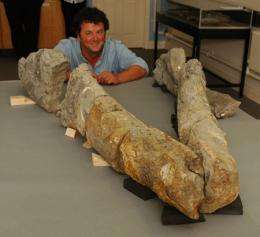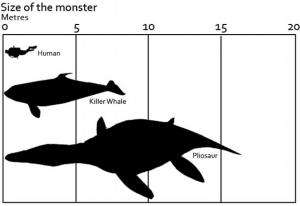Giant Skull of 12m Pliosaur 'Sea Monster' Unearthed in England

The fossilised skull of a pliosaur, the largest marine reptile that ever lived, has been discovered along the Jurassic Coast World Heritage Site.
Found on the shores of Weymouth Bay, experts believe the head - measuring more than two metres long - contains the biggest jaws ever found in Britain, and possibly the world.
The monster find has been secured with funding from the Heritage Lottery Fund, plus Dorset and Devon county councils, and will be prepared for permanent display at the Dorset County Museum in Dorchester.
This pliosaur lived in the Jurassic seas that covered Dorset 155 million years ago and was at least 12 metres long. The jaws were powerful enough to bite a small car in half.
In 2006 a pliosaur skeleton was discovered at Svalbard in northern Norway, but the skull was missing. And initial investigations indicate that the Weymouth Bay skull belonged to an even bigger animal.
Dr David Martill of Portsmouth University said: "This is one of the largest, if not the largest, pliosaur skull found anywhere in the world and contains features that have not been seen before. It could be a species new to science."
The skull - which is 90 per cent complete - was discovered by local fossil hunter Kevan Sheehan, who recovered the heavy fragments over a number of years from a Dorset beach. Mr Sheehan said:

"In 40 years of collecting, I have often been green with envy at some of the finds other people have made. But now when someone shows me a find, I can say: ‘that's not a fossil....this pliosaur, that's a fossil!'"
Richard Edmonds, earth science manager for the Jurassic Coast World Heritage Site, said:
"Kevin has done a fantastic job, rescuing this huge fossil over several years. Without his efforts,the specimen would have been lost to the sea."
The pliosaur skull is just the latest fossil to be discovered on the Jurassic Coast, Britain's only natural World Heritage Site, which runs along 95 miles of the Devon and Dorset coastline.
Looking for fossils is hugely popular along the coast but, as with any area with cliffs, there are hazards. The best fossils are found on the beaches, not the cliffs, which are prone to rock falls at any time. People should always stay well away from the cliffs.

In wet weather, mudflows can be a further hazard and another good reason to stay on the beach. People should also check the tides - the best time to search for fossils is when the tide is going out.
Richard Edmonds added:
"We encourage people to look for fossils at Lyme Regis and Charmouth in Dorset. Here fossils can be found on the beaches and will simply be washed away if not collected. The best way to get started is to go on one of the many guided walks led by local experts.
"If people do it properly, looking for fossils can be great fun - though I'm afraid we can't guarantee that you will find anything quite as large as the pliosaur. This is a once-in-a-lifetime find."
Source: Jurassic Coast World Heritage Site



















